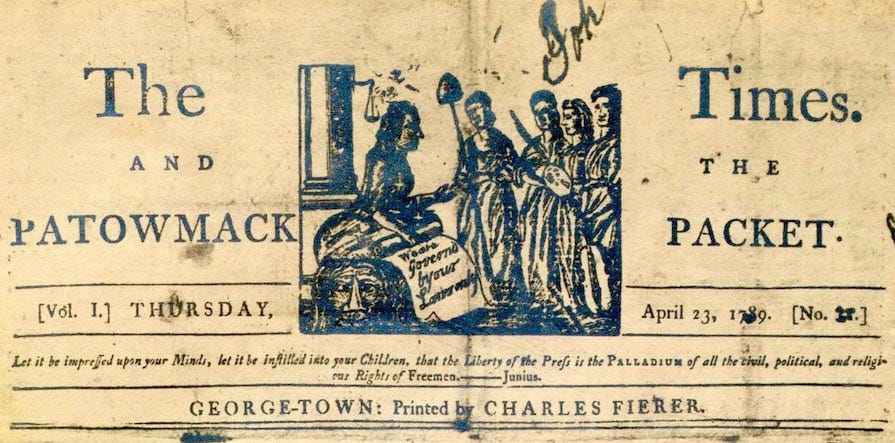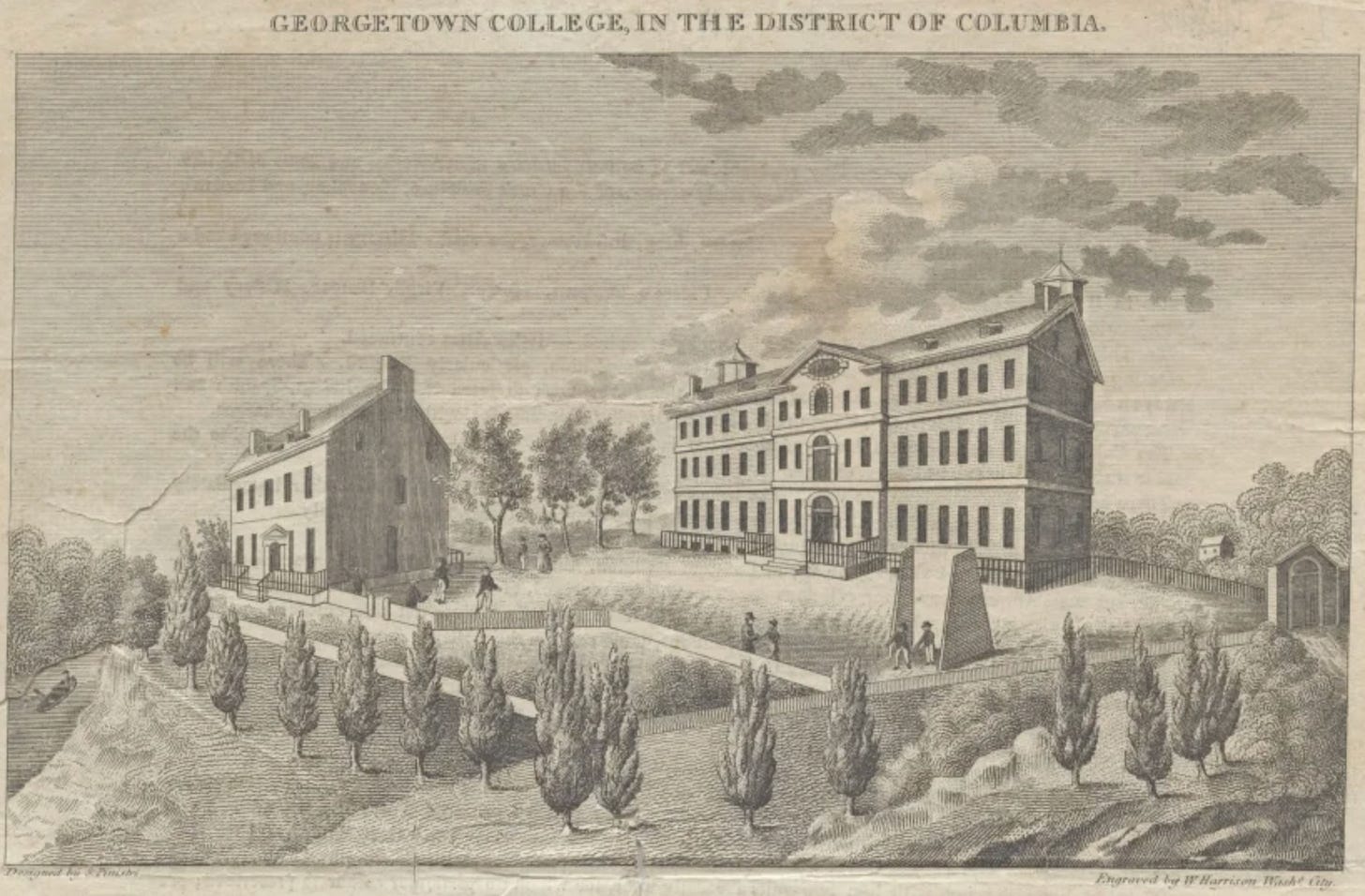(Re)Introducing the "Patowmack Packet"
On Washington's first newspaper (and a new blog)
As far as is known, it has been 233 years since the “Patowmack Packet” was last published. This new blog about Washington, D.C., and its history adopts the name of this long-forgotten, yet historic, publication.
Sometime in early 1789, probably on February 12, a couple of months before George Washington was inaugurated as the first U.S. President, a German named Charles Fierer began publishing the first newspaper in Georgetown, which was then an independent city in Maryland. The full name of Fierer’s paper was The Times, and Patowmack Packet, and if not long-lived, it holds its distinction as the first newspaper printed in what is now the District of Columbia.
It is more than a little ironic that Fierer published the first paper in what would be the capital of the United States, since he arrived on these shores as a soldier to help crush American independence. Fierer was a Hessian mercenary, employed by the British to fight the American rebels, yet he had the bad luck to be stationed at Trenton, New Jersey, in late-1776. He was captured there, perhaps soon after General George Washington made his famous Christmas crossing, on December 25, 1776. As an officer, he was then paroled, and a year and a half or so later, in August 1778, he defected to Washington himself. The next year, Fierer was enrolled among the Virginians fighting in the Southern campaign. He stayed in Virginia after the war and by 1789, had settled in George-Town, opening a printer’s shop and then founding the Packet. That same year he helped open Masonic Lodge No. 9, in Georgetown, the first Freemason’s lodge in what would become the District of Columbia (and which is now Lodge No. 5, still in Georgetown), and served as its inaugural grand-master. The best account of Fierer’s rather turbulent life can be found in a 1936 article by Alice Lerch.
But it was as the publisher of The Times, and Patowmack Packet that Fierer deserves to be most remembered. The Packet appears to have been published weekly, on Thursdays, but the earliest extant edition of the paper is one copy held by the Library of Congress, dated April 23, 1789, which was the eleventh number of the first volume. For the paper’s motto, Fierer chose an epigram of the anonymous English commentator Junius: "Let it be imprinted on your minds, let it be instilled in your children, that the liberty of the press is the palladium of all the civil, political, and religious rights of freemen.”
We don’t know why Fierer decided either to start a newspaper or why he did so in Georgetown. The city at this time was nearly four decades old, having been founded in 1751. The Federal City, as Washington, D.C., would be known, did not yet exist, though the year after Fierer started the Packet the act founding the national capital was passed, President Washington famously picked the site, and planning for its construction began under the young French engineer Pierre Charles L’Enfant. By comparison, Georgetown already was an established tobacco port and there were great hopes that it would become a major transhipment point for agricultural goods coming down the Potomac to fill the oceangoing vessels that then sailed downriver into Chesapeake Bay.
An early description of Georgetown was provided in 1793 by James Kent, first professor of law at Columbia University:
"George-Town", he wrote, "…is a pleasant Village situated on the waving Hills on the N. side of the Potomack & about 1 mile W. of the President's House in the City - a small stream called Rock-Creek separating this Town from the City. This Town has a fine view of the Potomack. It has a beautiful appearance from the S. side of the River, & the Hills on the back of the Town which are improved & improving with handsome Country Seats & which in some Situations will now sell for 50 guineas an acre, command a noble View of the Town, of the City of Washington & of the Potomack quite down to Alexandria. Mason's Island in front of the E. End of the Town adds much to the Beauty of the view. The Houses are exceedingly well built of Brick. The Town may contain 150 families & between 30 & 40 very good brick Buildings…George-Town is larger now, & has more trade than Baltimore had in 1775. A view from George-Town up the Potomack is as rugged as up the Hudson from Poghkeepsie…”
(A later view of Georgetown, in 1855)
In the same year that Fierer started the Packet and organized Lodge No. 9, Bishop John Carroll, first Roman Catholic archbishop in the United States, was constructing a building for a new academy in the town, which eventually would become the first Roman Catholic college in the country. On his visit four years later, James Kent observed of what is now Georgetown University:
“They have an Academy here under the Direction of a President & vice-President who are Romish Priests. The House now used is a large square 2 Story brick building on a most salubrious & commanding Eminence at the W. End of the Town - a new Building is begun near the same place - Tho the Academy is but of two years old they have now between 80 & 90 Scholars drawn from all quarters, & principally from Roman Catholic families. The Protestants don't relish it. 3 Boys came with me from Phil. This academy contemplates to give Degrees. It gives great attention to the Scholars. A Physician visits them daily, & it is growing rapidly.”
(A view of Georgetown College, showing (l) Old South (razed in 1904) and (r) Old North Buildings, circa 1829)
The tobacco trade, the college, the more healthful location than the swamps of the capital city, all lent an energy and attractiveness to Georgetown that seemed to justify Fierer’s gamble on opening a weekly circular. Newspapers in the 18th century were not investigative outlets and had few “stories.” Mostly they were announcements of sailings and arrivals, advertisements of goods for sale, official announcements, recent speeches, and some basic news, usually copied from other newspapers. Occasional commentary pieces were published, usually anonymously, and often by the editor. With so few copies in existence, it is hard to assess if the Patowmack Packet broke any new ground in journalism, but it is highly unlikely. Rather, being located in a minor but growing river port, Fierer’s newspaper undoubtedly catered to Georgetown’s local business interests. Alice Lerch noted it did provide frequent coverage of the activities of Lodge No. 9, due no doubt to Fierer’s role in Masonry, which was the one respect in which it may have differed from other broadsheets.
Despite the all the factors in its favor, within just two years, by July 1791, the Patowmack Packet had discontinued publishing. The paper’s closure quite likely was due to Fierer’s indebtedness and apparently rather prickly relations with erstwhile partners and creditors. Moving on to Dumfries, Virginia, Fierer continued in the newspaper business, but never made a success of it. He died, little lamented and soon forgotten, on December 9, 1794, just five years after founding the first paper in the federal district. Washington, D.C., would soon be filled with storied newspaper names like the National Intelligencer, the Washington Star, and the Washington Post, leaving the Patowmack Packet all but forgotten.
On that somber note, we take our leave of Charles Fierer and turn next to the re-launch of The Patowmack Packet and the etymology of “Patowmack.”






